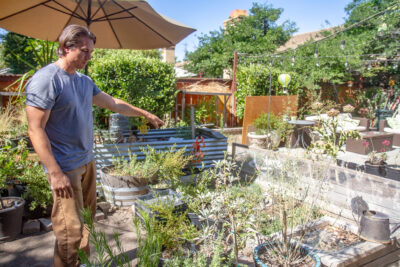It looked like a perfect Wednesday summer morning in Santa Clarita. I was walking my 5-year-old son to his nearby school — so close that even his small legs could manage without complaint. As we strolled hand in hand, I cherished the moment, aware of how fleeting these early years are.
But nothing about this walk is effortless. We live in one of the wealthiest areas I’ve ever called home — because a client offered us rent below market rate. It was a chance I couldn’t pass up for my kids. And yet, even discounted, the cost is crushing. I’m not living the suburban dream. I’m surviving inside it. I pretend, for my children. I stretch and contort to stay in a neighborhood that promises them more than I ever had. That, too, is part of the illusion.
As we approached the manicured greenbelt maintained by our homeowners’ association, the gardeners were hard at work. My son asked what they were doing. As we neared, they paused, turned off their blowers and edgers, and greeted us with warm smiles. I thanked them; they’re always so kind, especially given the pace and heat they work in.
I explained to my son that each day they maintain a section of the area. Today was our turn. Seeing the company logo on their truck, I wondered if they were paid fairly. The average wage for a gardener in California is about $22 an hour. But the living wage here is nearly $29. That gap says a lot: The men who maintain the illusion of suburban prosperity often can’t afford to live inside it.
And that illusion? It’s thirsty. Despite frequent droughts, we continue to pour millions of gallons into lawns. Nationally, lawn irrigation accounts for nearly one-third of residential water use — about nine billion gallons a day, according to the EPA. In a desert. During a megadrought. Fertilizers leach into the soil and water tables. We prop up monocultures where biodiversity once thrived.
It’s not just unsustainable — it’s absurd.
And it’s not new. Lawns have colonial roots. In 17th-century England, they signaled that you had so much land you didn’t need to farm. That aesthetic crossed the Atlantic and bloomed on Southern plantations, where enslaved people maintained the lawns. Later, immigrants, often Latino, took up the shears.
This history lives on. We just don’t call it what it is. We call it landscaping. We forget that every greenbelt and front yard is upheld by labor — hot, invisible labor. The men I pass daily do backbreaking work in 100-degree heat, often without health care or job security. Their politeness doesn’t soften the injustice; it exposes it. That smile? It’s more generous than the system they work under.
Lawns aren’t just grass. They’re class. They’re conformity. The HOA’s unspoken racial code for “acceptable.” A suburban version of the picket fence dream — soaked in water, labor and illusion.
I’ve tried to resist in small ways. The patch of green we inherited has been shrinking. First I pulled out bark mulch that floated off in rainstorms. Then I replaced it with rocks, native plants and shade. Less water. Less pretense. It’s not radical, but it’s intentional.
And while we’re still here — before the house is sold and we have to move — I try to notice the truths behind the mirage. Because I know how lucky we are. Not just to walk to school safely, but to do it beside open green space. Most inner-city kids don’t have that. Studies show low-income and urban communities, often communities of color, have far less access to safe parks and trees. That disparity shows up in asthma rates, obesity, even school performance.
I preach to myself with these observations. I ask: Is it true? What does the data say? And it confirms what I feel. My morning walk may feel like a fairy tale — but for many families, it’s a fiction.
Who is this all for? Who defines what’s beautiful?
We’re still telling a story with our landscapes. Still clinging to the illusion. Still pouring water and labor into a false Eden.
But nothing about it is natural. And nothing about it is free. It’s time to tell the truth.
MaryElizabeth Olsen
Valencia












